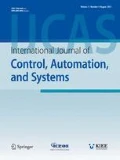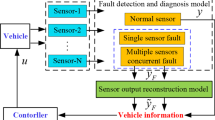Abstract
Electrical wiring interconnection system (EWIS) of civil aircraft has been paid more attention in recent years, and intermittent failure detection of electrical connectors in EWIS is a challenging problem. This paper presents a sliding mode observer (SMO) approach for the intermittent failure detection of an aircraft electrical system with multiple connector failures. The mathematical model of the aircraft electrical system which contains multiple connector failures is established for transforming the intermittent failure detection problem into observer-based multiplicative faults isolation and estimation problems. A set of adaptive sliding mode observers are designed to locate the failure connectors preliminarily, the observers can adapt the unknown upper bound of the faults. Furthermore, a fault-reconstruction scheme applying the equivalent output error injection principle is proposed for fault estimation, where the characteristic parameters of connecters are reconstructed to identify the failures. Finally, a numerical example is provided to show the effectiveness of the proposed method.
Similar content being viewed by others
References
FAA. FAR25. Airworthiness standards: transport category airplanes. 2007.
W. B. Ren, P. Wang, and X. M. Ma, “Intermittent phenomenon of electrical contacts induced by fretting behavior,” Tribology, vol. 33, no. 4, pp. 382–387, 2013.
V. B. Prasad, “The effects of intermittent faults on the reliability of digital systems,” Proc. of IEEE Southeastcon’90, pp. 948–952, 1990.
D. H. Zhou, J. T. Shi, and X. He, “Review of intermittent fault diagnosis techniques for dynamic systems,” Acta Automatica Sinica, vol. 40, no. 2, pp. 161–171, 2014. [click]
W. G. Zanardelli, E. G. Strangas, and S. Aviyente, “Identification of intermittent electrical and mechanical faults in permanent-magnet AC drives based on time–frequency analysis,” IEEE Trans. on Industry Applications, vol. 43, no. 4, pp. 971–980, 2007.
W. G. Zanardelli and E. G. Strangas, “Methods to identify intermittent electrical and mechanical faults in permanent magnet AC drives based on wavelet analysis,” Proc. of Vehicle Power and Propulsion, pp. 154–160, 2005. [click]
S. M. Bennett, R. J. Patton, and S. Daley, “Torque and flux estimation for a rail traction system in the presence of intermittent sensor faults,” Proc. of UKACC International Conference on Control, pp. 72–77, 1996.
M. Y. Chen, G. B. Xu, and R. Y. Yan, “Detecting scalar intermittent faults in linear stochastic dynamic systems,” International Journal of Systems Science, vol. 46, no. 8, pp. 1337–1348, 2015. [click]
Z. Q. Wu, Y. Yang, and C. H. Xu, “Adaptive fault diagnosis and active tolerant control for wind energy conversion system,” International Journal of Control, Automation and Systems, vol. 13, no. 1, pp. 120–125, 2015. [click]
G. B. Xu, “Researches on fault diagnosis and prediction in dynamic systems,” Ph.D. Disssertation, Tsinghua University, China, 2011.
Y. J. Liu and S. C. Tong, “Adaptive fuzzy identification and control for a class of nonlinear pure-feedback MIMO systems with unknown dead zones,” IEEE Trans. on Fuzzy Systems, vol. 23, no. 5, pp. 1387–1398, 2015.
Y. J. Liu, S. Li, and S. C. Tong, “Neural approximation based adaptive control for a class of nonlinear nonstrict feedback discrete-time systems,” IEEE Trans. on Neural Networks and Learning Systems, DOI: 10.1109/TNNLS.2016.2531089.
A. Maouche, M. Saad, and B. Bensaker, “High gain adaptive observer design for sensorless state and parameter estimation of induction motors,” International Journal of Control, Automation and Systems, vol. 13, no. 5, pp. 1106–1117, 2015. [click]
K. Zhang, B. Jiang, and J. J. Liu, “Fast fault accommodation of control systems by using adaptive observer,” Control and Decision, vol. 23, no. 7, pp. 771–775, 2008.
Z. Y. Shen, J. Zhao, and X. S. Gu, “Multiplicative faults detection and reconstruction in linear dynamic systems using robust sliding mode observers,” Proc. of the 7th World Congress on Control and Automation, pp. 2761–2765, 2008.
S. Rahme and N. Meskin, “Adaptive sliding mode observer for sensor fault diagnosis of an industrial gas turbine,” Control Engineering Practice, vol. 38, pp. 57–74, 2015. [click]
W. Chen, “Multiplicative fault estimation using sliding mode observer with application,” Proc. of International Conference on Control, Automation and Robotics, pp. 163–167, 2015.
S. Laghrouche, J. X. Liu, and F. S. Ahmed, “Adaptive second-order sliding mode observer-based fault reconstruction for PEM fuel cell air-feed system,” IEEE Trans. on Control Systems Technology, vol. 23, no. 3, pp. 1098–1109, 2015.
C. Liu, Y. H. Li, X. H. Zhu, and P. P. Liu, “Adaptive slidingmode observer for actuator fault reconstruction in nonlinear system with mismatched uncertainties,” Control Theory and Applications, vol. 31, no. 4, pp. 431–437, 2014.
J. Q. Yang, F. L. Zhu, and X. Wang, “Robust sliding-mode observer-based sensor fault estimation, actuator fault detection and isolation for uncertain nonlinear systems,” International Journal of Control, Automation and Systems, vol. 13, no. 5, pp. 1037–1046, 2015. [click]
H. A. Talebi and K. Khorasani, “A neural network-based multiplicative actuator fault detection and isolation of nonlinear systems,” IEEE Trans. on Control Systems Technology, vol. 21, no. 3, pp. 842–851, 2013.
X. D. Zhang, M. M. Polycarpou, and T. Parisini, “A robust detection and isolation scheme for abrupt and incipient faults in nonlinear systems,” IEEE Trans. on Automatic Control, vol. 47, no. 4, pp. 576–593, 2002.
N. Meskin and K. Khorasani, “Actuator fault detection and isolation for a network of unmanned vehicles,” IEEE Trans. on Automatic Control, vol. 54, no. 4, pp. 835–840, 2009.
W. T. Chen and M. Saif, “Observer-based strategies for actuator fault detection, isolation and estimation for certain class of uncertain nonlinear systems,” IET Control Theory and Applications, vol. 1, no. 6, pp. 1672–1680, 2007.
W. T. Chen and M. Saif, “A sliding mode observer-based strategy for fault detection, isolation, and estimation in a class of Lipschitz nonlinear systems,” International Journal of Systems Science, vol. 38, no. 12, pp. 943–955, 2007. [click]
F. Zhu and J. Yang, “Fault detection and isolation design for uncertain nonlinear systems based on full-order, reduced-order and high-order high-gain sliding-mode observer,” International Journal of Control, Automation and Systems, vol. 86, no. 10, pp. 1800–1812, 2013. [click]
Author information
Authors and Affiliations
Corresponding author
Additional information
Recommended by Associate Editor Guang-Hong Yang under the direction of Editor Duk-Sun Shim. This work is supported by the Fund of Aeronautics Science Foundation of China (No. 20138052060).
Shaojie Zhang is an Associate professor at the College of Automation Engineering, Nanjing University of Aeronautics and Astronautics. He received his Ph.D. degree from the College of Automation Engineering, Nanjing University of Aeronautics and Astronautics in 2009. His research interest covers nonlinear system control and fault tolerant control.
Zhen Cai is a graduate student at the College of Automation Engineering, Nanjing University of Aeronautics and Astronautics. Her research interest covers fault diagnosis and reliability.
Rights and permissions
About this article
Cite this article
Zhang, S., Cai, Z. Intermittent failure detection of multiple electrical connectors in EWIS. Int. J. Control Autom. Syst. 15, 557–566 (2017). https://doi.org/10.1007/s12555-015-0474-4
Received:
Revised:
Accepted:
Published:
Issue Date:
DOI: https://doi.org/10.1007/s12555-015-0474-4




